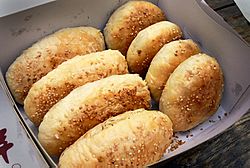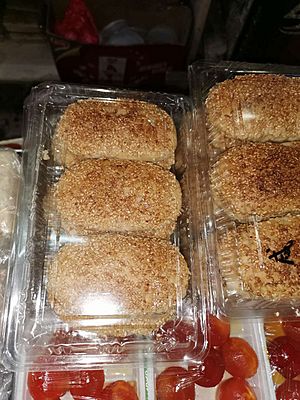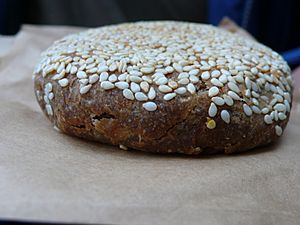Shaobing facts for kids

Typical shaobing. The round shaobing on the right are sweet and filled with sugar and the long shaobing on the left are savory and salted.
|
|
| Alternative names | Huoshao |
|---|---|
| Type | Flatbread |
| Course | Breakfast |
| Place of origin | China |
| Shaobing | |||||||||||||||||
|---|---|---|---|---|---|---|---|---|---|---|---|---|---|---|---|---|---|
| Traditional Chinese | 燒餅 | ||||||||||||||||
| Simplified Chinese | 烧饼 | ||||||||||||||||
| Literal meaning | roasted pastry | ||||||||||||||||
|
|||||||||||||||||
| Huoshao | |||||||||||||||||
| Traditional Chinese | 火燒 | ||||||||||||||||
| Simplified Chinese | 火烧 | ||||||||||||||||
| Literal meaning | fire roasted | ||||||||||||||||
|
|||||||||||||||||
Shaobing (pinyin: shāobǐng; Wade–Giles: shao-ping), also known as huoshao, is a popular baked flatbread from Northern China. It's a type of bread that doesn't use yeast to rise. Shaobing can be plain or filled with different ingredients. Many kinds also have sesame seeds on top.
Shaobing fillings can be either savory or sweet. Some common sweet fillings include red bean paste or black sesame paste. Savory options might have stir-fried mung beans with egg and tofu, or even braised beef and spiced pork.
This tasty flatbread is very popular in the northern parts of China. It's not as well known in southern China. Different types of shaobing are often famous in specific cities or towns.
Shaobing is a common breakfast food. If it's filled, people often eat it with soy milk and tea. Plain shaobing might be served with steamed eggs or a breakfast meat dish. In Beijing, shaobing is sometimes eaten with hot pot during winter.
Contents
History of Shaobing
Ancient Chinese stories say that shaobing came from a place called the Xiyu. This was a name for parts of Central Asia. A general from the Han dynasty, Ban Chao, is said to have brought it back. It was first called hubing, which means "barbarian pastry."
Shaobing is thought to be related to other flatbreads. These include naan from Persia and Central Asia, and pita from the Near East. During the Tang dynasty, people from western countries even made and sold sesame cakes in China.
Types of Shaobing
Huangqiao Shaobing
Huangqiao Shaobing (Huangqiao Sesame Cake) is a special kind of shaobing. It is made from flour, oil, sesame, and other ingredients. This shaobing is golden in color and very crispy on the outside.
Traditionally, Huangqiao Shaobing comes in two flavors: sweet and salty. The sweet ones are usually round. The salty ones are often long and oval-shaped.
Zhoucun Shaobing
Zhoucun Shaobing is a famous traditional snack from Zibo, a city in Shandong province, China. It was created by a person named Guo Yunlong. He based it on a thick pancake shaped like a horseshoe.
This shaobing is very thin and round, almost like paper. The front side is covered with sesame seeds. The back has many small, crispy holes. Zhoucun Shaobing is well-known because it's super crispy and can be stored for a long time.
Magao (Changzhou Sesame Cake)
Magao (Changzhou Sesame Cake) is another type of shaobing. It is very popular in Changzhou, a city in Jiangsu province. Changzhou Sesame Cake can be round or oval.
The traditional flavors for Magao are sweet, salty, and spicy. It has a golden, thin, and crispy skin. To make this cake, chefs use fine ingredients like pig fat, white flour, sesame seeds, sugar, and salt. They bake it in a special traditional barrel furnace.
See also
 In Spanish: Shaobing para niños
In Spanish: Shaobing para niños




